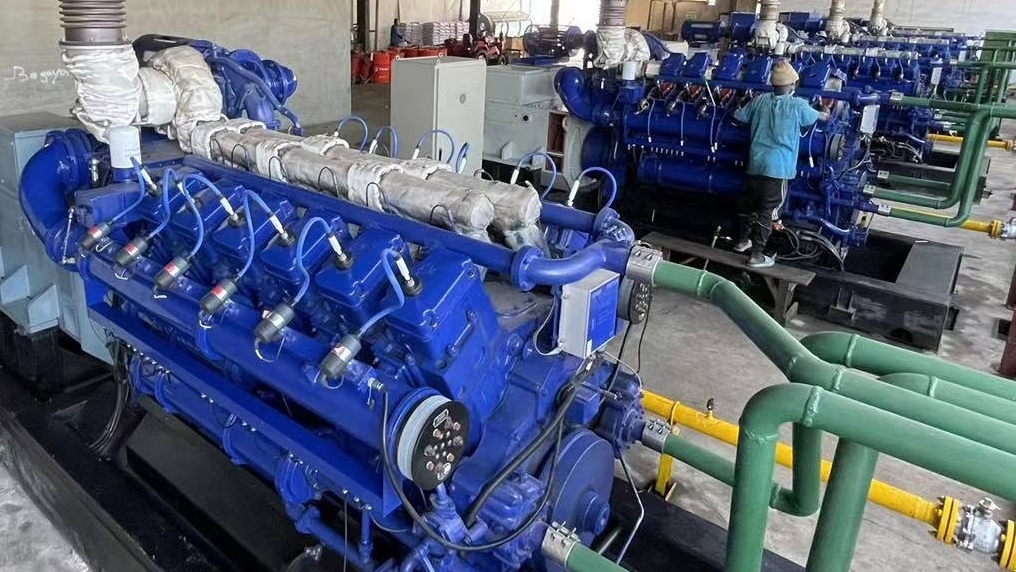—— 燃料發(fā)電設(shè)備及機組相關(guān)配套設(shè)備及配件 ——
 全國服務(wù)熱線:
全國服務(wù)熱線:

 全國服務(wù)熱線:
全國服務(wù)熱線:
 濟南濟柴環(huán)能燃氣發(fā)電設(shè)備有限公司
濟南濟柴環(huán)能燃氣發(fā)電設(shè)備有限公司
聯(lián)系電話:羅總18653152416
服務(wù)熱線:0531-62325028
聯(lián)系地址:中國(山東)自由貿(mào)易試驗區(qū)濟南片區(qū)孫村街道經(jīng)十東路33688號章錦綜合保稅區(qū)聯(lián)東U谷科創(chuàng)中心5號樓101
在工業(yè)生產(chǎn)的能量轉(zhuǎn)換戰(zhàn)場上,工業(yè)尾氣發(fā)電機組如同一位 “變廢為寶” 的勇士,將原本廢棄的尾氣轉(zhuǎn)化為電能。然而,一旦氣體發(fā)生泄漏,不僅會降低發(fā)電效率,更可能帶來安全隱患。為了保障設(shè)備安全穩(wěn)定運行,一場與氣體泄漏的 “嗅覺保衛(wèi)戰(zhàn)” 時刻在上演,多種檢測手段如同敏銳的 “嗅覺衛(wèi)士”,精準(zhǔn)捕捉每一絲異常。
On the battlefield of energy conversion in industrial production, industrial exhaust gas generators are like warriors who turn waste into treasure, converting the originally discarded exhaust gas into electrical energy. However, once a gas leak occurs, it not only reduces power generation efficiency but may also pose safety hazards. In order to ensure the safe and stable operation of equipment, a "smell defense battle" against gas leaks is constantly unfolding, with various detection methods acting like sharp "smell guards", accurately capturing every trace of abnormality.
光學(xué)檢測技術(shù)堪稱這場 “保衛(wèi)戰(zhàn)” 中的 “火眼金睛”。其中,紅外成像檢測方法利用氣體對特定波長紅外光的吸收特性來發(fā)現(xiàn)泄漏點。當(dāng)含有泄漏氣體的區(qū)域與周圍環(huán)境存在紅外輻射差異時,紅外熱像儀就像擁有透視能力的 “偵察兵”,能夠捕捉到這種細微變化,將泄漏氣體在畫面中以不同顏色或明暗程度呈現(xiàn)出來,操作人員通過觀察熱像圖,可快速定位泄漏位置,即便在復(fù)雜的設(shè)備結(jié)構(gòu)中,也能精準(zhǔn)找出泄漏點。激光檢測技術(shù)同樣不容小覷,它向目標(biāo)區(qū)域發(fā)射特定頻率的激光束,當(dāng)激光穿過泄漏氣體時,氣體分子會與激光發(fā)生相互作用,導(dǎo)致激光的強度、頻率等參數(shù)發(fā)生改變,通過檢測這些變化,就能判斷是否存在氣體泄漏以及泄漏的程度,這種檢測方式靈敏度高,可在遠距離外實現(xiàn)對泄漏氣體的快速檢測,避免操作人員近距離接觸危險區(qū)域。
Optical detection technology can be regarded as the "golden eyes" in this "defense battle". Among them, the infrared imaging detection method utilizes the absorption characteristics of gases towards specific wavelengths of infrared light to detect leakage points. When there is a difference in infrared radiation between the area containing leaked gas and the surrounding environment, the infrared thermal imager is like a "scout" with perspective ability, which can capture this subtle change and present the leaked gas in different colors or brightness levels in the picture. By observing the thermal image, the operator can quickly locate the leak location, even in complex equipment structures, and accurately find the leak point. Laser detection technology should not be underestimated. It emits a laser beam of a specific frequency towards the target area. When the laser passes through the leaked gas, gas molecules will interact with the laser, causing changes in parameters such as laser intensity and frequency. By detecting these changes, the presence and degree of gas leakage can be determined. This detection method has high sensitivity and can achieve rapid detection of leaked gas from a distance, avoiding operators from coming into close contact with dangerous areas.
傳感器檢測是 “嗅覺保衛(wèi)戰(zhàn)” 中的 “先鋒部隊”。催化燃燒式傳感器通過催化作用使可燃氣體在其表面發(fā)生無焰燃燒,燃燒產(chǎn)生的熱量會引起傳感器溫度升高,進而導(dǎo)致其電阻值發(fā)生變化,通過檢測電阻值的改變,就能確定可燃氣體的濃度,以此判斷是否出現(xiàn)泄漏;電化學(xué)傳感器則利用氣體在電極上發(fā)生的氧化還原反應(yīng)產(chǎn)生的電信號來檢測氣體濃度,不同的氣體在電極上的反應(yīng)不同,產(chǎn)生的電信號也有差異,從而可以識別出特定的泄漏氣體并監(jiān)測其濃度。此外,半導(dǎo)體氣體傳感器憑借其對氣體吸附和解吸后電導(dǎo)率發(fā)生變化的特性,對多種氣體泄漏都能做出靈敏響應(yīng),這些傳感器就像分布在設(shè)備各處的 “哨兵”,24 小時不間斷地監(jiān)測氣體濃度,一旦濃度超過設(shè)定閾值,便立即發(fā)出警報。
Sensor detection is the "vanguard force" in the "olfactory defense battle". Catalytic combustion sensors cause flameless combustion of combustible gases on their surfaces through catalytic action. The heat generated by combustion causes the temperature of the sensor to rise, resulting in a change in its resistance value. By detecting the change in resistance value, the concentration of combustible gases can be determined to determine whether a leak has occurred; Electrochemical sensors use the electrical signals generated by the oxidation-reduction reactions of gases on electrodes to detect gas concentration. Different gases react differently on electrodes, resulting in different electrical signals. This allows for the identification of specific leaked gases and monitoring of their concentrations. In addition, semiconductor gas sensors, with their characteristic of changing conductivity after gas adsorption and desorption, can respond sensitively to various gas leaks. These sensors are like "sentinels" distributed throughout the equipment, continuously monitoring gas concentration 24 hours a day. Once the concentration exceeds the set threshold, an alarm will be immediately issued.

壓力檢測法是從氣體泄漏引發(fā)的物理變化入手,堪稱 “物理偵察兵”。在工業(yè)尾氣發(fā)電機組的氣體輸送管道系統(tǒng)中,正常運行時管道內(nèi)的壓力處于穩(wěn)定狀態(tài)。通過在管道關(guān)鍵部位安裝壓力傳感器,實時監(jiān)測管道內(nèi)壓力變化。當(dāng)某處發(fā)生氣體泄漏時,泄漏點后方的壓力會迅速下降,而泄漏點前方的壓力則會有所上升,根據(jù)壓力傳感器采集到的這些壓力波動數(shù)據(jù),結(jié)合流體力學(xué)原理和管道結(jié)構(gòu)參數(shù),利用算法模型進行分析計算,就能準(zhǔn)確判斷出是否發(fā)生泄漏以及泄漏的大致位置,就像通過血壓變化診斷人體健康問題一樣,從壓力數(shù)據(jù)中發(fā)現(xiàn)氣體泄漏的 “病癥”。
The pressure detection method starts from the physical changes caused by gas leaks and can be called a "physical reconnaissance soldier". In the gas transmission pipeline system of industrial exhaust gas generators, the pressure inside the pipeline is in a stable state during normal operation. By installing pressure sensors at critical parts of the pipeline, real-time monitoring of pressure changes inside the pipeline can be achieved. When a gas leak occurs in a certain area, the pressure behind the leak point will rapidly decrease, while the pressure in front of the leak point will increase. Based on the pressure fluctuation data collected by the pressure sensor, combined with the principles of fluid mechanics and pipeline structure parameters, using algorithm models for analysis and calculation, it is possible to accurately determine whether a leak has occurred and the approximate location of the leak, just like diagnosing human health problems through changes in blood pressure, and discovering the "symptoms" of gas leaks from pressure data.
聲學(xué)檢測技術(shù)則是 “聽覺偵察兵”,利用氣體泄漏時產(chǎn)生的特殊聲音來發(fā)現(xiàn)隱患。當(dāng)氣體從管道或設(shè)備的縫隙中泄漏時,會因高速流動與周圍介質(zhì)摩擦產(chǎn)生獨特的聲波,這種聲波的頻率和強度與正常運行時的聲音存在差異。聲學(xué)檢測設(shè)備通過高靈敏度的麥克風(fēng)或聲波傳感器收集這些聲音信號,再運用信號處理技術(shù)對采集到的聲音進行分析,將其與預(yù)先設(shè)定的正常聲音模式進行對比,一旦檢測到異常聲音特征,就可以判斷出存在氣體泄漏,并根據(jù)聲音的傳播特性和強度,大致確定泄漏點的位置,如同通過細微異響發(fā)現(xiàn)機器故障一般,從聲音中捕捉泄漏的蛛絲馬跡。
Acoustic detection technology is called "auditory reconnaissance", which uses the special sound generated when gas leaks to detect hidden dangers. When gas leaks from gaps in pipelines or equipment, it generates unique sound waves due to high-speed flow and friction with surrounding media. The frequency and intensity of these sound waves differ from those during normal operation. Acoustic detection equipment collects these sound signals through high-sensitivity microphones or sound wave sensors, and then uses signal processing technology to analyze the collected sound and compare it with a pre-set normal sound pattern. Once abnormal sound features are detected, it can be determined that there is gas leakage. Based on the propagation characteristics and intensity of the sound, the location of the leakage point can be roughly determined, just like detecting machine faults through subtle abnormal sounds, capturing the clues of leakage from the sound.
本文由工業(yè)尾氣發(fā)電機組友情奉獻.更多有關(guān)的知識請點擊:http://www.hcxqgw.cn我們將會對您提出的疑問進行詳細的解答,歡迎您登錄網(wǎng)站留言.
This article is a friendly contribution from a biogas generator set For more information, please click: http://www.hcxqgw.cn We will provide detailed answers to your questions. You are welcome to log in to our website and leave a message


掃一掃了解更多

掃一掃了解更多